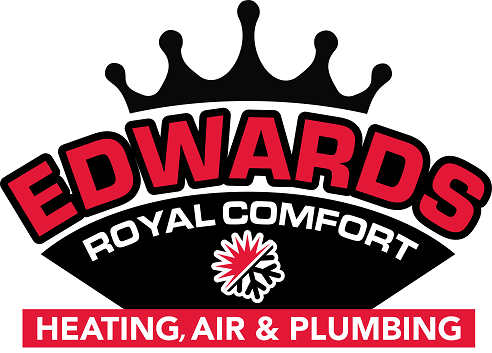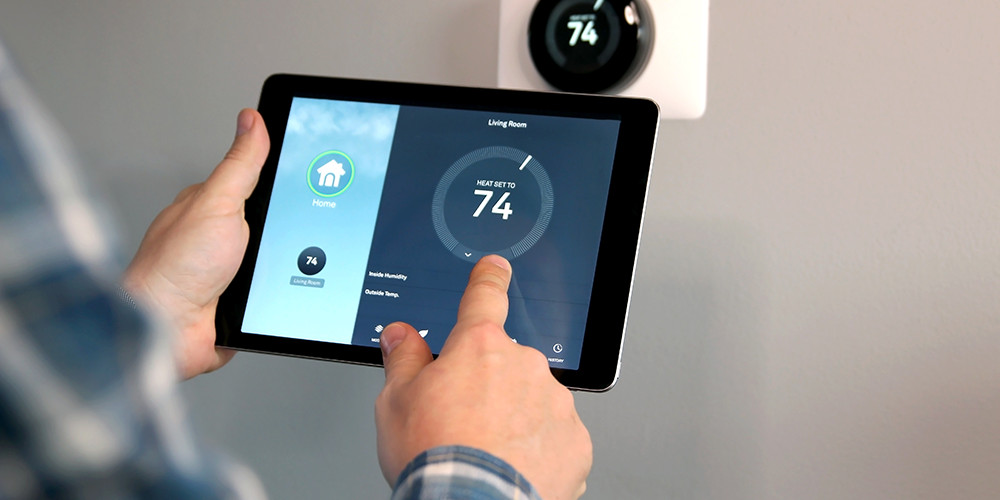Thermostats are a critical part of every home comfort system, controlling how you communicate with and control your heating and cooling equipment. For many years, the programmable thermostat was the top tool for improving the energy efficiency of furnaces and air conditioners – but today’s smart thermostat has begun to take over the market. How does a smart thermostat work and what makes them so popular? Edwards Royal Comfort has the answers.
How Does a Smart Thermostat Work?
A smart thermostat is a type of smart home device that allows for automated and remote control over the home’s heating and cooling units through integration with smart home hubs and connected apps. Smart thermostats use a Wi-Fi connection to connect homeowners to their HVAC systems while at home or away when using a smart device or computer with an Internet connection.
Through Wi-Fi connectivity, homeowners are easily able to adjust and control temperature settings in the home for better comfort and energy conservation. This is made possible through a variety of technologies that allow these systems to automatically select energy-efficient temperature settings.
- Learning technology allows the thermostat to learn homeowner habits, schedules, and temperature preferences over a period of time for effective automation. Homeowners never have to touch the thermostat to adjust settings and achieve ideal temperatures.
- Pairing smart thermostats with occupancy sensors tells the unit when the home is occupied or unoccupied, allowing for automated adjustments.
- Geofencing technology allows the smart thermostat to detect the location of connected household members. When people are away from home, the thermostat can set more efficient settings to save you money.
The Rise and Fall of Programmable Thermostats
Programmable thermostats have held a substantial portion of the residential thermostat market for more than two decades, steadily increasing in popularity since ENERGY STAR first promoted them for improving heating and cooling efficiency in 1995. As of the U.S. Energy Information Administration’s 2015 Residential Energy Consumption Survey, 58.9 percent of U.S. households report using a programmable thermostat. Only 4 percent of households report using a smart or Internet-enabled thermostat in 2015.
Homeowners were told installing a programmable thermostat could lower home heating and cooling costs by 10 to 30 percent, but over time, these savings didn’t seem to materialize. Research found homeowners were not using their programmable thermostats the proper way to lower heating and cooling energy consumption, due to issues such as incorrect use or disinterest.
Smart Thermostats Actually Achieve Energy Savings
In 2007, the first smart thermostat was introduced to the market. This revolutionized the thermostat industry, providing an HVAC system control that was able to lower heating and cooling energy consumption. The key differences between the two types of thermostats are remote connectivity and automation.
Although programmable thermostats can save homeowners significant money, studies have shown people were not using them correctly. With the introduction of the smart thermostat, this mission critical problem was eliminated. Smart thermostats can save about 12 percent on heating costs and 15 percent on cooling costs, although actual savings depends on factors such as system usage, home and household size, and more.
Because of their energy-saving qualities, the popularity of smart thermostats have skyrocketed over the past 10 to 15 years. In 2016, 7.8 million North American homes used smart thermostats. By the end of 2021, some experts project over 43 million smart thermostats will be in use, which is 40 percent of the total households in the U.S.
Contact Edwards Royal Comfort for Smart Thermostat Installation
Schedule an appointment for new smart thermostat installation, and take advantage of the benefits a new thermostat can bring to your household. For all of your heating and cooling needs, contact Edwards today.


